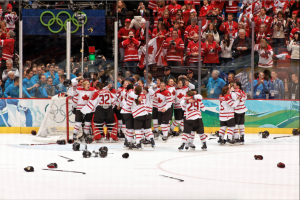By: Elizabeth Chokler
Female hockey players continue to face barriers in joining teams, not being taken seriously and making less money as professionals than their male counterparts.

Women’s hockey started gaining popularity in universities in the 1890s, and today there are women’s Olympic teams, women’s leagues and co-ed teams. However, women in hockey continue to face challenges due to their gender.
These challenges include facing barriers in joining teams, not being taken seriously within the sport and making less money as professionals than their male counterparts.
“It was often assumed the girls weren’t capable, so they shouldn’t be touched or passed to,” said Sasha Codrington about her experience training on a co-ed team. “Then, if you showed any skill, they would hate being shown up by a girl and try really hard to prove themselves.”
Codrington is a first-year fashion communication student who played hockey for 11 years. She played on both girls’ and co-ed teams. She said there was also an issue where the rinks she played in would claim that they didn’t have enough change rooms for the girls to have their own.
Sara Blair, a first-year undeclared arts student, started playing hockey when she was eight. She played house league for three years and played competitively for seven.
Blair said that she faced a challenge when she tried out for the co-ed hockey team in Grade 6. She said her principal short-shifted the girls who made the team.
“We weren’t the best players but there was still no need to have shortened our shifts or made us sit for no reason,” Blair said. “It was middle school hockey and supposed to be an inclusive environment for everyone to have a good time. It just wasn’t fair, and the boys that were worse than us didn’t sit.”
Blair said that even the rules are different for girls than for boys, as female hockey players aren’t allowed to hit whereas in the boys’ league they are: “Do they think women can’t handle the hits?” Blair said. “Or do they think guys can handle them?”

Meira Greenbaum, a second-year geographic analysis student, started playing hockey in Grade 7. She played in a co-ed house league, an all-girls house league and on a high school girls’ hockey team.
In her first season, she played with boys and faced challenges on the co-ed team.
“I was one of the two girls on the team, and we had a separate change room area,” Greenbaum said. “Because of this, we were left out of the team discussion where the coaches talked about the game strategy. I was a pretty good skater and could actually keep up with most of the boys, but they never passed the puck to me even if I was open.”
As Greenbaum got older, she switched to an all-girls house league and joined the girls’ hockey team in high school. She said that although playing with girls only was a more enjoyable experience, she still got rude comments from guys.
How about the pros?
The National Women’s Hockey League, established in 2015, is the first U.S. women’s hockey league to pay its players, according to their website.
Though the NHL pays its players up to $15 million, the NWHL pays salaries of $2,000 to $10,000 this season. Last season they paid their players $10,000 to $27,000.
The Canadian Women’s Hockey League among others, don’t pay their players at all, requiring the women to have other jobs. This also means they can’t dedicate as much time to train and practice.
See our video on the Ryerson Rams women’s hockey team here.
Infographic by Josh Cameron



Leave a Reply